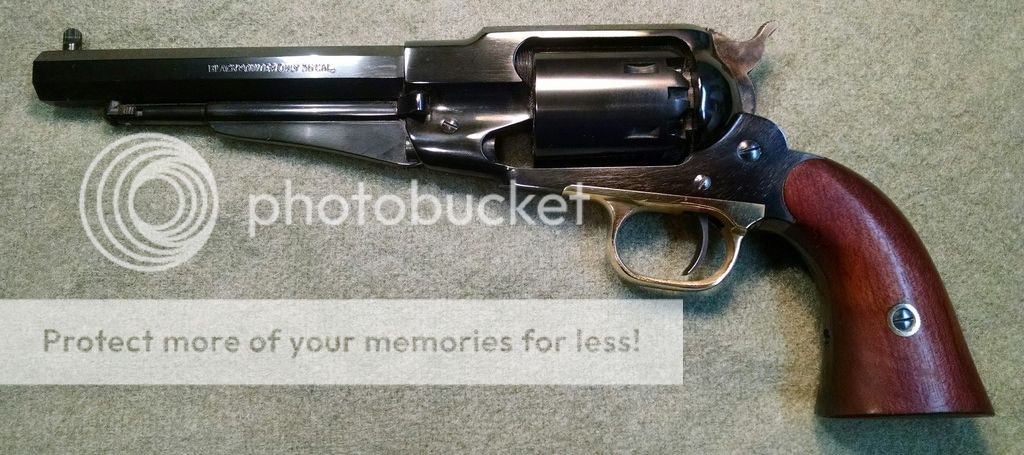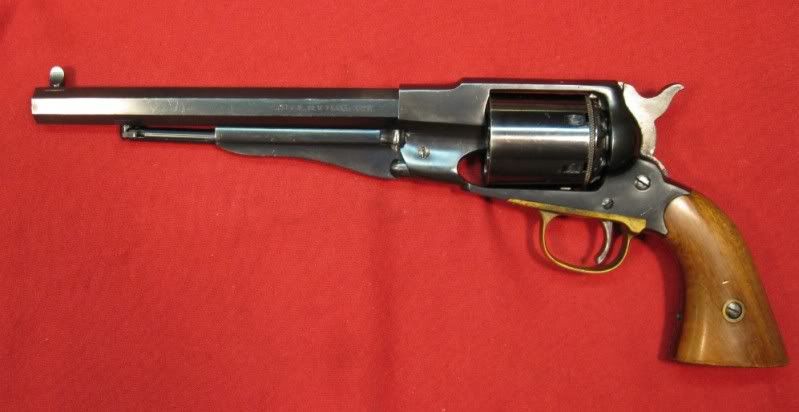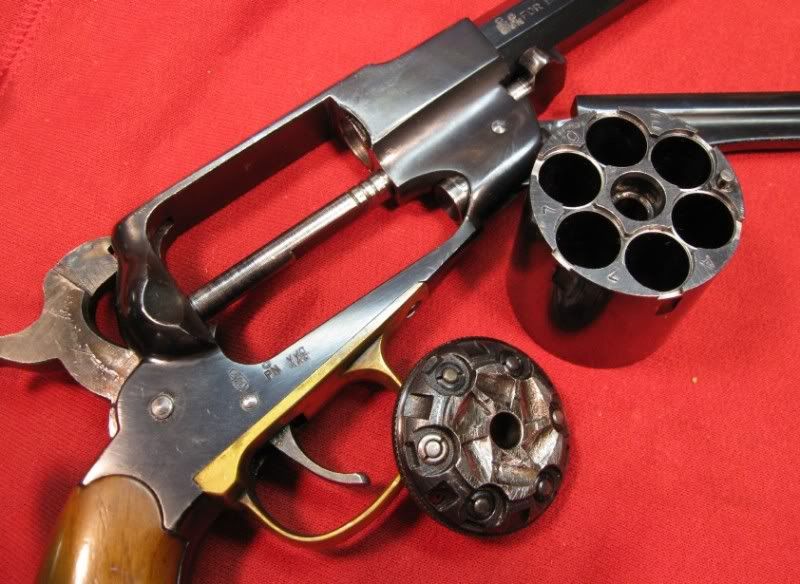OK, here's the deal with why the 1858 Remington tends to bind up quickly with Black Powder fouling.
The main cause of a cylinder binding with BP fouling is that fouling blasted out of the barrel cylinder gap gets deposited directly onto the cylinder pin. Forget everything you've heard about barrel/cylinder gap dimensions, that is not as critical as the fact that fouling is being blasted at high pressure onto the pin itself. BP fouling is dry and gritty. As the cylinder rotates the fouling works its way further onto the pin and as more fouling builds up between the pin and the cylinder, the binding gets worse.
The cylinder pin of the 1858 design is very narrow, only about 1/4" in diameter. The cylinder arbor of a Colt type design is larger in diameter. In addition, when you pop the cylinder out of a Colt you will notice there is a helical groove cut around the cylinder pin. The groove is there to provide clearance for fouling to be deposited in without filling up the tiny space between the cylinder and the arbor. So the larger diameter of the Colt arbor spreads out the fouling over a larger area, while the helical groove provides clearance. That is why Remmies tend to bind up more quickly than a Colt. You can see I chucked up the pin of my old EuroArms Remmie in my drill press and cut some crude clearance grooves in it quite a while ago, in an attempt to simulate the clearance grooves of a Colt. Not very successful. Perhaps if I had a lathe and cut grooves more precisely and more closely spaced it would have worked better. But I am not a skilled lathe operator, and with that narrow pin I was concerned with cutting too deep. When I am shooting my Remmie I load up the cylinder pin with bore butter, but even so, I take the cylinder out and wipe off the face of it with a damp rag after every cylinderfull, or it will start to bind. Seeing as the cylinder is so easy to pop out of a Remmie, this is not much of a chore.

But the story of BP fouling binding cylinders does not end there. You will notice both the Colt design and the Remington design have flat faced cylinders. With these guns, the cylinder butts right up against the frame, with just a little bit of clearance designed in. The barrel of the Remington is threaded into the frame flush with the cylinder opening, the barrel cylinder gap is determined by the amount of clearance between the cylinder and the frame.
But the important fact is that with both designs there is a clear, open path for fouling that is blasted out of the barrel/cylinder gap to be deposited directly onto the exposed cylinder pin or arbor.

Now let's take a look at how Smith and Wesson dealt with the problem of Black Powder binding up cylinders. S&W never built any percussion revolvers, they didn't have to. S&W controlled the Rollin White patent for cylinders bored straight through to accept cartridges. Starting in 1857 S&W started building their Tip Up model revolvers. Here is a photo showing the three different sizes they made, from smallest to largest the 22 Rimfire #1, the 32 Rimfire #1 1/2, and the 32 Rimfire #2.

The Tip Ups were very simple revolvers. To load them you released a latch and tipped the barrel up, hence the name. You pulled the cylinder straight out and poked out the empties with the rod that was pressed in under the barrel. The little nub on the front of the cylinder fitted into a recess under the barrel for the for the cylinder to rotate around. Then you popped the cylinder back in place, swung down the barrel and latched it and you were ready to go. Notice too that with the Tip Ups the cylinder bore directly against the frame.

The White patent was in force until 1869, and all that time Colt was chafing at the bit because they could not build a cartridge revolver until the White patent expired. The Thuer conversion was an attempt to get around the White patent, but it was not a very successful design. To make matters worse, Rollin White was a former Colt employee and he had offered to sell his patent to Sam Colt who in what was probably the worst business decision of his life, had passed.
But I digress.
Smith and Wesson assumed that Colt and everybody else had been working on their own cartridge designs and would be ready to pounce once the White patent expired. It didn't work out that way, but that's another story. But S&W had been diligently working on a radically new revolver design so they would have a better mouse trap than everybody else when the White patent expired. The new design was the first of the Top Break designs. It was a big, 44 caliber revolver that automatically ejected the empties when you broke the gun open, you did not have to poke out the empties one at a time like you would eventually have to do with the 1873 Colt. The new S&W design was eventually known as the American model. I don't own an American, but this New Model Number Three illustrates S&W's thinking on what to do about Black Powder fouling binding up Cylinders. Notice the helical groove cut into the cylinder arbor directly under the end of the barrel. Look familiar? It is there for clearance exactly like the helical groove on the Colt C&B arbor.

In addition to the clearance groove, S&W pressed a bushing onto the front face of the cylinder, so it was no longer flat faced.

When the gun is closed up, the bushing rides outside the cylinder arbor. Notice how the cylinder does not bear directly against the frame, the bushing does. The bushing provides horizontal separation between the barrel/cylinder gap and the opening at the front of the cylinder bushing. What this means is the arbor is shielded from nasty fouling blasted out of the barrel/cylinder gap. I can shoot this revolver with Black Powder cartridges all day long and it never binds up. Clever guys at S&W.

Colt messed around with cartridge conversions for a few years, but when the Single Action Army came out in 1873 they had done their homework. They added a bushing to the front of the cylinder. Colt bushings are a slip fit and are removable. The cylinder and bushing on the left are from an Uberti Cattleman, the cylinder and bushing on the right are from a 2nd Gen Colt.

Here, the bushings have been slipped into place. Oh my goodness, what's that in the middle? A Ruger Vaquero cylinder with a great big bushing cut directly onto the front of the cylinder.

With the Colt, the bushing does the same job as the bushing on the S&W cylinder. It provides horizontal separation between the barrel/cylinder gap and the front of the cylinder bushing, shielding the cylinder pin from almost all of the fouling blasted out of the barrel/cylinder gap.

The Vaquero illustrates the separation a little bit better. I can shoot a Colt or a Vaquero all day long with Black Powder cartridges and the cylinders never bind up.

Remington was not far behind, when they introduced their Model 1875 Army cartridge revolver, it too had a bushing on the front of the cylinder.
So in a nutshell, that's why the 1858 Remington tends to bind up so quickly with BP fouling, and how revolver manufactures came up with solutions to the problem. I don't know what this new magic lube is that folks are raving about, but I'm sure it works well. But the
best solution to getting the 1858 to shoot without binding is to find a gunsmith who can fabricate a bushing to press onto the front of the cylinder and make a clearance cut into the frame to accommodate the bushing. A friend of mine used to do that and it worked great, but unfortunately he is retired now.
Incidentally, you may have read that the modern reproductions of the S&W Top Breaks made by Uberti do not perform will with Black Powder but tend to bind up easily. This is true. The reason is that Uberti 'stretched' the length of their cylinders to accept longer cartridges such as 45 Colt, but did not stretch the frames a corresponding amount. Instead they skimped on the bushing at the front of the cylinders to fit the longer cylinders into a frame the same basic size as the originals. There is still a bushing there, but it is too short to allow enough horizontal separation between the barrel/cylinder gap and the front of the bushing to effectively shield the arbor from fouling blasted out of the barrel/cylinder gap.















